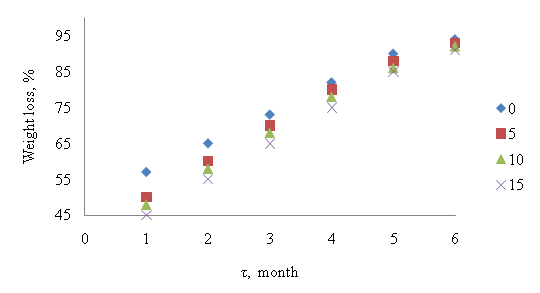Study of lignite humic acids hybrid modification technology of biodegradable films based on polyvinyl alcohol
DOI:
https://doi.org/10.15587/2706-5448.2023.277980Keywords:
brown coal, humic acids, hybrid modification, polyvinyl alcohol, antibacterial properties, biodegradable filmsAbstract
Object of article study is lignite humic acids hybrid modification technology of biodegradable films based on polyvinyl alcohol. The possibility of increasing the strength and operational properties of biodegradable polymeric materials based on polyvinyl alcohol by using its modification with the different types of humic acids from lignite is considered. Lignite humic acids hybrid modification films with antibacterial properties were obtained. The two-stage technology of lignite humic acids hybrid modification of biodegradable films based on polyvinyl alcohol was formalized. At the first stage of lignite humic acids hybrid modification technologies for hybrid-modified biodegradable materials production, lignite humic acids are received. At the second stage, hybrid modification of lignite humic acids (that are part of biodegradable polyvinyl alcohol films), which are received by watering from a solution, takes place. It has been conducted a study on determining the effect of lignite humic acids hybrid modification on the most important operational properties of biodegradable film based on polyvinyl alcohol, i. e., tensile strength, relative elongation at break and time of mold appearance. Changes in tensile strength, relative elongation at break and time of mold appearance for the lignite humic acids hybrid modified biodegradable polymeric materials based on polyvinyl alcohol were revealed depending on the content of the different types of lignite humic acids. It was also shown that the lignite humic acids hybrid modification of polyvinyl alcohol with the different types of humic acids allows preserving the biodegradability of the films along with imparting the antibacterial properties. The developed lignite humic acids hybrid modified biodegradable polyvinyl alcohol films with antibacterial properties, in terms of their operational characteristics, are superior to the known similar biodegradable films based on natural biopolymers.
References
- Alves Dias, P., Kanellopoulos, K., Medarac, H., Kapetaki, Z., Miranda Barbosa, E., Shortall, R., Tzimas, E. (2018). EU coal regions: opportunities and challenges ahead, EUR 29292 EN. Publications Office of the European Union. Luxembourg. doi: https://dx.doi.org/10.2760/064809
- Belov, O., Shustov, O., Adamchuk, A., Hladun, O. (2018). Complex Processing of Brown Coal in Ukraine: History, Experience, Practice, Prospects. Solid State Phenomena, 277, 251–268. doi: https://doi.org/10.4028/www.scientific.net/ssp.277.251
- Babets, Ye. K., Bielov, O. P., Shustov, O. O., Barna, T. V., Adamchuk, A. A. (2019). The development of technological solutions on mining and processing brown coal to improve its quality. Naukovyi Visnyk Natsionalnoho Hirnychoho Universytetu, 6, 36–44. doi: https://doi.org/10.29202/nvngu/2019-6/6
- Cabrera, F. C. (2021). Eco‐friendly polymer composites: A review of suitable methods for waste management. Polymer Composites, 42 (6), 2653–2677. doi: https://doi.org/10.1002/pc.26033
- Debiagi, F., Kobayashi, R. K. T., Nakazato, G., Panagio, L. A., Mali, S. (2014). Biodegradable active packaging based on cassava bagasse, polyvinyl alcohol and essential oils. Industrial Crops and Products, 52, 664–670. doi: https://doi.org/10.1016/j.indcrop.2013.11.032
- Falguera, V., Quintero, J. P., Jiménez, A., Muñoz, J. A., Ibarz, A. (2011). Edible films and coatings: Structures, active functions and trends in their use. Trends in Food Science & Technology, 22 (6), 292–303. doi: https://doi.org/10.1016/j.tifs.2011.02.004
- Gómez-Aldapa, C. A., Velazquez, G., Gutierrez, M. C., Rangel-Vargas, E., Castro-Rosas, J., Aguirre-Loredo, R. Y. (2020). Effect of polyvinyl alcohol on the physicochemical properties of biodegradable starch films. Materials Chemistry and Physics, 239, 122027. doi: https://doi.org/10.1016/j.matchemphys.2019.122027
- Brandelero, R. P. H., Brandelero, E. M., Almeida, F. M. de. (2016). Biodegradable films of starch/PVOH/alginate in packaging systems for minimally processed lettuce (Lactuca sativa L.). Ciência e Agrotecnologia, 40 (5), 510–521. doi: https://doi.org/10.1590/1413-70542016405010516
- Lebedev, V. V., Miroshnichenko, D. V., Savchenko, D. O., Tykhomyrova, T. S. (2022). Design and researching of hybrid eco-friendly biodegradable films with bactericidal properties. Scientific Notes of Taurida National V.I. Vernadsky University. Series: Technical Sciences, 3 (33 (72)), 87–91. doi: https://doi.org/10.32838/2663-5941/2022.3/14
- Miroshnichenko, D., Lebedeva, K., Cherkashina, A., Lebedev, V., Tsereniuk, O., Krygina, N. (2022). Study of Hybrid Modification with Humic Acids of Environmentally Safe Biodegradable Hydrogel Films Based on Hydroxypropyl Methylcellulose. C, 8 (4), 71. doi: https://doi.org/10.3390/c8040071
- EN 14995:2006 Plastics. Evaluation of the ability to biochemical decomposition. Test procedure and technical conditions (2018). Available at: http://online.budstandart.com/ua/catalog/doc-page.html?id_doc=80595#:~:text=%D0%94%D0%A1%D0%A2%D0%A3%20EN%2014995%3A2018%20%D0%9F%D0%BB%D0%B0%D1%81%D1%82%D0%BC%D0%B0%D1%81%D0%B8,EN%2014995%3A2006%2C%20IDT Last accessed: 29.11.2022

Downloads
Published
How to Cite
Issue
Section
License
Copyright (c) 2023 Vladimir Lebedev, Denis Miroshnichenko, Tetiana Tykhomyrova

This work is licensed under a Creative Commons Attribution 4.0 International License.
The consolidation and conditions for the transfer of copyright (identification of authorship) is carried out in the License Agreement. In particular, the authors reserve the right to the authorship of their manuscript and transfer the first publication of this work to the journal under the terms of the Creative Commons CC BY license. At the same time, they have the right to conclude on their own additional agreements concerning the non-exclusive distribution of the work in the form in which it was published by this journal, but provided that the link to the first publication of the article in this journal is preserved.







